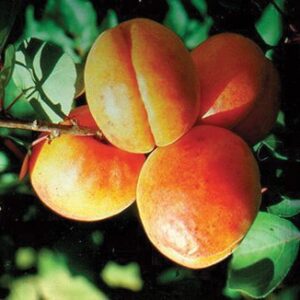Apricot : HUNZA Semi-Dwarf (Mustang)
$61.95
This unique variety grows wild in the Hunza valley in northwest Pakistan. Small, sweet fruits with exquisite flavour have an edible kernel within the pit, which has been the primary source of oil for the Hunza people for many years. The longevity of these folks has attracted attention, since many live to be 100 or more. Among the contributing factors being credited for this are the aforementioned apricot kernels. If the Hunza want dried fruit, they simply leave the apricots hanging on the tree. The flesh reportedly has a deep, delicious toffee taste when cooked.
SELF-FERTILE | ZONE 5 | HARVEST : AUG
Rootstocks
G41 Dwarf
(2.5-3.1m/8-10ft)
G935 Small Semi-Dwarf
(3.25-4m/10-13ft)
G969 Small Semi-Dwarf
(3.25-4m/10-14ft)
G30 Semi-Dwarf
(3.6-5m/12-16ft)
G890 Semi-Dwarf
(3.6-5m/13-16ft)
Pollenator definitions
Some trees and many berry plants are SELF-FERTILE ̶means the insect pollinators or even the wind can pollinate the blossoms without the need of a second tree.
NEEDS A POLLENIZER ̶ means another tree of the same type or kind but a different variety must be blooming nearby at the same time.
EXAMPLE A Liberty apple and a Wealthy apple can cross-pollinate. Two trees of the same variety ie: ̶ 2 Wealthy apples, cannot cross pollinate because they are genetically identical.
Other trees are marked as SEMI-FERTILE. These will set fruit without a second tree. However they will often bear more, and sometimes larger fruit if another variety of the same kind of tree is nearby.
You can select 2 different trees of the same kind marked as NEEDS A POLLENIZER or plant one of those along with one SELF-FERTILE or one SEMI-FERTILE. Also consider ripening times ̶ a Goldrush apple might not start blooming before a Pristine is finished.
NEEDS A POLLENIZER ̶ means another tree of the same type or kind but a different variety must be blooming nearby at the same time.
EXAMPLE A Liberty apple and a Wealthy apple can cross-pollinate. Two trees of the same variety ie: ̶ 2 Wealthy apples, cannot cross pollinate because they are genetically identical.
Other trees are marked as SEMI-FERTILE. These will set fruit without a second tree. However they will often bear more, and sometimes larger fruit if another variety of the same kind of tree is nearby.
You can select 2 different trees of the same kind marked as NEEDS A POLLENIZER or plant one of those along with one SELF-FERTILE or one SEMI-FERTILE. Also consider ripening times ̶ a Goldrush apple might not start blooming before a Pristine is finished.



